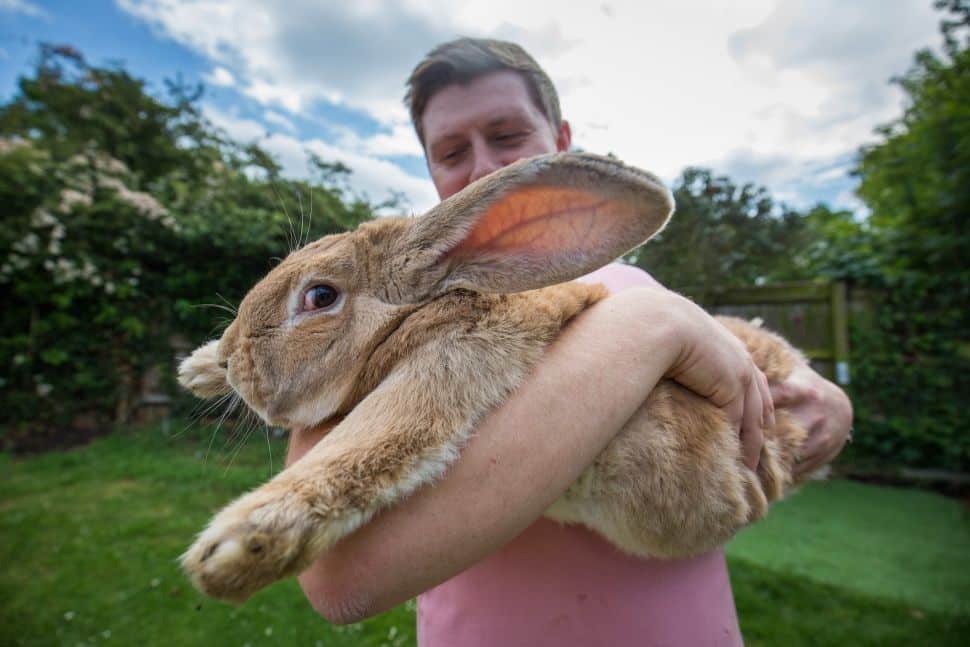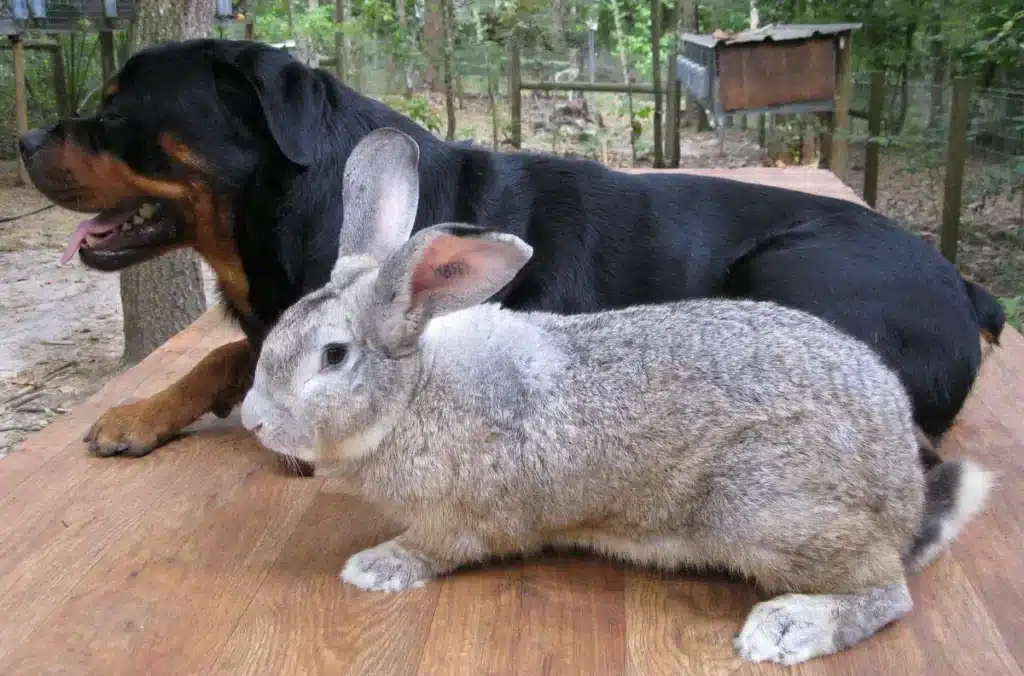In the realm of rabbits, the Flemish Giant stands as a true marvel. Picture this a rabbit so large that at first glance, it might be mistaken for a canine companion. Weighing an impressive average of 15 pounds and stretching up to 2.5 feet in length, these giants are in a league of their own.
The Flemish Giant rabbit holds the title of being the largest domestic rabbit breed. With a history rooted in utility, these majestic creatures were initially bred for their fur and meat. However, their gentle disposition and patience when handled have endeared them to many, leading them to become cherished pets.

What is the Scientific Name of the Flemish Giant Rabbit?
Scientific names might sound complex, but they’re like special labels for animals. The scientific name for the Flemish Giant rabbit is “Oryctolagus cuniculus.” It’s like giving the rabbit a special code that scientists everywhere can understand. Just like your name, this name tells us what kind of rabbit it is.
Where Do the Flemish Giant Rabbits Live?
Flemish Giant rabbits usually live in places where they feel cozy and safe. These rabbits are domestic, which means they live with people. People keep them as pets in homes and even in outdoor spaces.
They are rarely found in the wild like other rabbits. So, you will most likely see them hopping around in gardens or comfy cages.
What is the Size of Flemish Giant Rabbits?
Flemish Giant rabbits are like the basketball players of the rabbit world! They’re huge – average around 7-10 kgs in weight and about 2 – 2.5 feet long. That’s like having a rabbit friend that’s almost as big as a small dog. They’re super-sized and stand out among other rabbits.
How Does the Flemish Giant Rabbit Look Like?
Male and female Flemish rabbits have their special features. Males have broader heads, while females show off something called a dewlap. This dewlap is like a fancy scarf of skin under their chin that they use to keep their babies warm.
A top-quality Flemish Giant rabbit, has a big, well-shaped head, ears that stand tall, a long and strong body, fur that’s one color all over, and a round and cute back. Their fur comes in different shades – think black, blue, fawn, light gray, steel gray, sandy, and white – like a rainbow of rabbit colors.
Are Flemish Giant Rabbits Aggressive?
Flemish giant rabbits make great pets, they are some of the nicest bunnies around! They’re not the bossy type and don’t usually get angry. These rabbits are calm and patient, even when you hold them. They make good friends and are happy to hang out with people.
But remember, just like kids have different personalities, rabbits do too. They can become threatened or frightened easily. When they do, they will act like a normal rabbit does to protect itself, including kicking, biting, thrashing, and scratching. Taking care of them and spending time together helps them stay friendly and happy.
Do Flemish Giant Rabbits Make Good Pets?
So, you’re wondering if Flemish Giant rabbits make awesome pals, right? Well, you’re in for a treat! These rabbits are like having a big, furry friend by your side. They’re really friendly and patient when you want to play or cuddle with them. Imagine having a gentle giant as your buddy – someone who’s not only cool but also loves being part of your family. Yep, these rabbits are pretty great pets!
How Are Flemish Giant Rabbits So Big?
Have you ever thought about how Flemish Giant rabbits become giants? It’s kind of like a magic trick called genetics.
These rabbits are man-made you can call them that because they are specially bred. The breeders combined a variety of meat and fur breeds to create the ultimate meat and fur rabbit.
Even though they’re the cozy pets we know today, Flemish Giants still have some wild traits. It’s like having a hint of their adventurous ancestors in them.
Now, the big question: Why are Flemish Giant rabbits so huge? These rabbits grow so big because they have been bred specifically for this trait. People who really liked big rabbits decided to help these rabbits become even bigger!
But guess what? In the wild, being super big isn’t such a good idea. It’s like wearing a “please eat me” sign for predators and sharing a bigger plate at the predator’s dinner table.
What Do Flemish Rabbits Eat?
Flemish Giant Rabbits have a menu that’s a mix of healthy stuff. Flemish giant rabbits are herbivores. They chomp on hay and grass, which is like their superfood. Veggies like carrots and lettuce are like their crunchy snacks. And they have protein pellets, which are like their special treats.
Just like us, these rabbits need a balanced diet to stay strong and happy. So, next time you see them nibbling, remember they’re enjoying their own version of a delicious meal! Your Flemish giant rabbit should be eating its body size in hay every day.
How Long Do Flemish Rabbits Live For?
On average, they stick around for about 7 to 10 years. Your furry companion for many birthdays and adventures. But just like all of us, they need good care to enjoy a long and happy life.
How Many Babies Can a Flemish Rabbit Have?
Baby rabbits, also called kits, are quite the bundle of joy. And Flemish Giant rabbits don’t hold back when it comes to kits! They can have a litter, which is like a bunch of baby bunnies, ranging from 4 to 12 kits.
Who is the Biggest Rabbit in the World?

The title of the largest individual rabbit on Earth belongs to Darius, a Continental Giant, The rabbit who weighed a whopping 50 pounds! and measures more than four feet in length! That’s like having a small dog-sized rabbit hopping around. Darius was bred in England by a breeder who produces extremely large Continental Giants.
What is the Status of the Flemish Giant Rabbit?
The Flemish Giant rabbit is not considered to be a threatened or endangered species, and therefore it doesn’t have conservation status. As a domesticated breed, they are actively bred and raised by breeders and enthusiasts worldwide. Still, they are listed as “near threatened” according to the IUCN.
However, it’s important to note that conservation status is typically associated with wild species that are at risk of extinction in their natural habitats. Domesticated breeds like the Flemish Giant rabbit are managed by breeders and aren’t subject to the same conservation concerns as wild animals.


